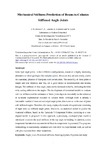Mostrar o rexistro simple do ítem
Mechanical stiffness prediction of beam-to-column stiffened angle joints
| dc.contributor.author | Loureiro, Alfonso | |
| dc.contributor.author | Gutiérrez, Ruth | |
| dc.contributor.author | López, Manuel | |
| dc.contributor.author | Reinosa, J.M. | |
| dc.date.accessioned | 2024-02-07T17:20:33Z | |
| dc.date.available | 2024-02-07T17:20:33Z | |
| dc.date.issued | 2019-11-28 | |
| dc.identifier.citation | J.M. Reinosa, A. Loureiro, R. Gutierrez, M. Lopez, Mechanical stiffness prediction of beam-to-column stiffened angle joints, Journal of Constructional Steel Research 168 (2020) 105875. https://doi.org/10.1016/j.jcsr.2019.105875. | es_ES |
| dc.identifier.issn | 1873-5983 | |
| dc.identifier.uri | http://hdl.handle.net/2183/35485 | |
| dc.description | Manuscrito aceptado | es_ES |
| dc.description.abstract | [Abstract]: Semi-rigid angle joints, in their different configurations, constitute a highly interesting alternative to other typologies like end plate joints. However, they are not widely used in the customary practice of European steel construction. The assembly of these joints is simple and cost effective, and they are a good choice in deconstruction and seismic designs. The stiffness of cleat angle joints can be increased either by preloading the bolts or by adding stiffeners to the angles. The development of theoretical models to evaluate both the stiffness and the resistance of these joints depends essentially on the existence of sufficient experimental evidence to validate them. Although there is already a reasonable number of tests on semi-rigid angle joints, this is not so in the case of joints with stiffened angles. Therefore, this study displays the results of experiments consisting of eight tests on stiffened angle joints. Moreover, an analytical model to predict the rotational stiffness, based on the Eurocode 3 Component Method according to a non-aligned model, is proposed. In this approach, a previously developed plate model is introduced to assess the axial stiffness of the top angle in bending. In addition, a new component that takes into account the stiffener in compression is presented. The proposed methodology is successfully validated with tests from the experimental work, as well as with previous tests from other researchers. | es_ES |
| dc.description.sponsorship | Financial support provided by the Spanish Ministerio de Economía y Competitividad and Fondo Europeo de Desarrollo Regional under contract BIA2016-80358-C2-2-P MINECO/FEDER UE is gratefully acknowledged. | es_ES |
| dc.language.iso | eng | es_ES |
| dc.publisher | Elsevier | es_ES |
| dc.relation | info:eu-repo/grantAgreement/MINECO/Plan Estatal de Investigación Científica y Técnica y de Innovación 2013-2016/BIA2016-80358-C2-2-P/ES/NUEVA METODOLOGÍA PARA LA CARACTERIZACIÓN DIRECTA Y AUTOMÁTICA DE UNIONES 2D VIGA-PILAR EMN ACERO MEDIANTE METAMODELOS ESPECIALIZADOS EN MODOS DE DEFORMACIÓN | es_ES |
| dc.relation.uri | https://doi.org/10.1016/j.jcsr.2019.105875 | es_ES |
| dc.rights | CC BY-NC-ND 4.0 https://creativecommons.org/licenses/by-nc-nd/4.0/deed.es | es_ES |
| dc.rights.uri | http://creativecommons.org/licenses/by-nc-nd/3.0/es/ | * |
| dc.subject | Angle joints | es_ES |
| dc.subject | Rotational stiffness | es_ES |
| dc.subject | Semi-rigid joints | es_ES |
| dc.subject | Experimental study | es_ES |
| dc.title | Mechanical stiffness prediction of beam-to-column stiffened angle joints | es_ES |
| dc.type | info:eu-repo/semantics/article | es_ES |
| dc.rights.access | info:eu-repo/semantics/openAccess | es_ES |
| UDC.journalTitle | Journal of Constructional Steel Research | es_ES |
| UDC.volume | 168 | es_ES |
| dc.identifier.doi | https://doi.org/10.1016/j.jcsr.2019.105875 |






